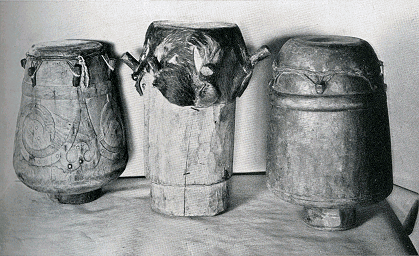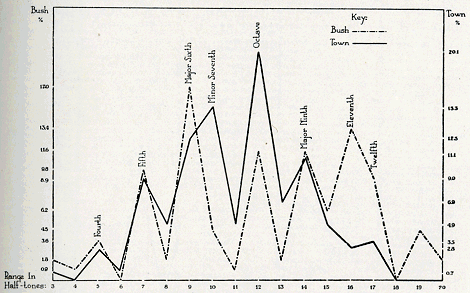Suriname folk-lore
(1936)–Melville J. Herskovits, Frances S. Herskovits–
[pagina 489]
| |
Part III Suriname musicTranscriptions and analyses by Dr. M. Kolinski
published under a grant from the american council of learned societies | |
[pagina 491]
| |
A. General statementThe study of Afro-American music is as significant from a musicological as from an ethnological point of view, for in the comparison of the musical styles of the various Afro-American peoples with one another, and with those of the African homeland, we may look for clarification of some of the important problems of acculturation. It already appears as a possibility that by an analysis of musical forms we may be able to follow gradations from the African dark-brown, so to speak, to the purest European white. Up to the present time the types of Afro-American music that have been generally known and discussed, are jazz and ‘the spirituals’. The fact, therefore, that New World Negro musical forms, other than these two, have been but little studied,Ga naar voetnoot1 enhances the value of the data presented here. For as the present study discloses, the songs of the Suriname Negroes are in large part typically African in their entire tonal, rhythmic and formal structure. This means that in spite of the sudden uprooting of the Dutch Guiana Negroes from their native soil, the decisive change that took place in their conditions of life, and their contact with foreign races, this element of their culture has been preserved partially unchanged for centuries. | |
B. Musicological analysis
| |
[pagina 492]
| |
of tones within one octave, or according to the occurrence of half-tones, appears to be of little value as a primary principle of classification, even though the number of tones as well as the anhemitonic character constitute in themselves important elements. Of far greater significance in determining the characteristics of the tonal structure is the manner in which the tones are connected, the greater or lesser melodic significance of the various tones, and the position of the tonal center, - the key-tone within the scale; in short, the functional relationships between the tones. Thus it may be said that the so-called anhemitonic-pentatonic scales are to be distinguished by an especially close binding of the tones. All tones in such scales are linked in fourths and fifths, the end points of the chain being separated from each other by not more than four steps of a fourth or a fifth each, (e.g., or or  ). Thus the tones employed always lie within a section of five tones, within the cycle of fifths; in the first example, it is the section c-g-d-a-e, in the second, b♭-f-c-g-d. All scales, then, whose tones lie within such a section of five tones from the cycle of fifths, - that is, the so-called anhemitonic-pentatonic scales, - as well as those having fewer tones, as for instance c-d-e (these being a part of the complex c-(g)-d-(a)-e), constitute a tonal type which may be called the ‘penta-type’. All scales whose tones lie within a section of six tones from the cycle of fifths, namely, scales of from two to six tones, like b-c (of the complex b-(e)-(a)-(d)-(g)-c) or e-f-g-a, (from: f-(c)-g-(d)-a-e) or g-a-b-c-d-e, (from: b-e-a-d-g-c), form what will be termed the ‘hexa-type’. All scales whose tones lie within a section of seven tones from the cycle of fitfhs, constitute the ‘hepta-type’; i.e., f-g-b (from: f-(c)-g-(d)-(a)-(e)-b) or d-e-f-g-a-b♭, (from: b♭-f-(c)-g-(d)-a-e). ). Thus the tones employed always lie within a section of five tones, within the cycle of fifths; in the first example, it is the section c-g-d-a-e, in the second, b♭-f-c-g-d. All scales, then, whose tones lie within such a section of five tones from the cycle of fifths, - that is, the so-called anhemitonic-pentatonic scales, - as well as those having fewer tones, as for instance c-d-e (these being a part of the complex c-(g)-d-(a)-e), constitute a tonal type which may be called the ‘penta-type’. All scales whose tones lie within a section of six tones from the cycle of fifths, namely, scales of from two to six tones, like b-c (of the complex b-(e)-(a)-(d)-(g)-c) or e-f-g-a, (from: f-(c)-g-(d)-a-e) or g-a-b-c-d-e, (from: b-e-a-d-g-c), form what will be termed the ‘hexa-type’. All scales whose tones lie within a section of seven tones from the cycle of fitfhs, constitute the ‘hepta-type’; i.e., f-g-b (from: f-(c)-g-(d)-(a)-(e)-b) or d-e-f-g-a-b♭, (from: b♭-f-(c)-g-(d)-a-e).
Different modes may be distinguished in accordance with the position of the key-tone. One might classify modes according to their key-tones, and this can be accomplished without employing sharps or flats; thus, one speaks of a do-, re-, mi-, fa-, sol-, la-, and si-mode. However, only the scales of the hepta-type can be thus defined unequivocally, since the cycle of fifths contains only one seven-tonal progression without accidentals, namely f-c-g-d-a-e-b. On the other hand the scales of the hexa- and penta-type may be built up from two or three tones, because the cycle of fifths contains two sections of tones which do not have any accidentals, namely, f-c-g-d-a-e and c-g-d-a-e-b, in addition to three sections of five tones without sharps and flats, namely, f-c-g-d-a, c-g-d-a-e, and g-d-a-e-b. From the point of view of the determination of mode, therefore, scales of the hexa-type have a two-fold, those of the penta-type a three-fold aspect. Thus, the scale g-a-b, with the key-tone g, may, for example, be deemed to belong not only to the sol mode, but to the do mode (c-d-e), and to the fa mode (f-g-a) as well. | |
[pagina t.o. 492]
| |
 Plate XIX. Left to right: Bush-Negro (Saramacca) Apinti drum, Haitian Voodoo-cult drum, Bush-Negro (Djuka) Apinti drum.
| |
[pagina 493]
| |
In the diagram of tonal structures the section of fiths c-g-d-a-e has thus been arbitrarily selected as representative of the penta-type the mode based on c being called the penta-do-mode; the mode based on d designated the penta-re-mode, etc. For the hexa-type, the progression c-g-d-a-e-b has been chosen, the mode based on c being termed the hexa-do-mode, and that based on d the hexa-re-mode, etc. Following the example of E.M. von Hornbostel, the different melodic values of the individual tones have been indicated in the analyses of tonal structures by employing notes of different values. In this way, fundamental tones have been expressed by whole notes; tones not structurally significant which are only occasionally employed have been expressed by quarter-notes. Structurally significant intervals are indicated by means of horizontal brackets ‘ ’; less important ones by brackets in dotted lines ‘ ’; less important ones by brackets in dotted lines ‘ ’. The sign, ’. The sign,  , above a note indicates the opening tone; inverted, , above a note indicates the opening tone; inverted,  , it indicates the closing one.
In the transcriptions of the songs the sign + or - above a note means that this note is raised or lowered in tone, up to approximately a quarter-tone. In exceptional cases, where a certain tone has been consistently raised throughout the whole song, (as for , it indicates the closing one.
In the transcriptions of the songs the sign + or - above a note means that this note is raised or lowered in tone, up to approximately a quarter-tone. In exceptional cases, where a certain tone has been consistently raised throughout the whole song, (as for
 Fig. 1. Tonal ranges of the songs.Ga naar voetnoot1
instance the a in song 68), then, to avoid repeating the sign throughout, this fact has been indicated by writing a + at the beginning each bar on of the line where this note occurs. A | |
[pagina 494]
| |
slanting line before or after a note (  , ,  ), or between two notes, ( ), or between two notes, ( ) indicates by its direction an upward or downward glissando. Parts enclosed by brackets, ‘[ ]’, have reference to deviations which result from repetition of songs, or parts of songs. Notes not distinctly audible on the phonograph records are placed in parentheses ‘( )’.Ga naar voetnoot1 ) indicates by its direction an upward or downward glissando. Parts enclosed by brackets, ‘[ ]’, have reference to deviations which result from repetition of songs, or parts of songs. Notes not distinctly audible on the phonograph records are placed in parentheses ‘( )’.Ga naar voetnoot1
Inasmuch as the relationship between the tones of a given melody is of foremost importance, and absolute pitch only of secondary significance, the major portion of the songs have not been transcribed in the key in which they were sung. Readability of the transcription has been the prime consideration in transposing the songs, and this has been accomplished by avoiding the use of many accidentals, and the necessity of adding additional lines to the staff. |
|

